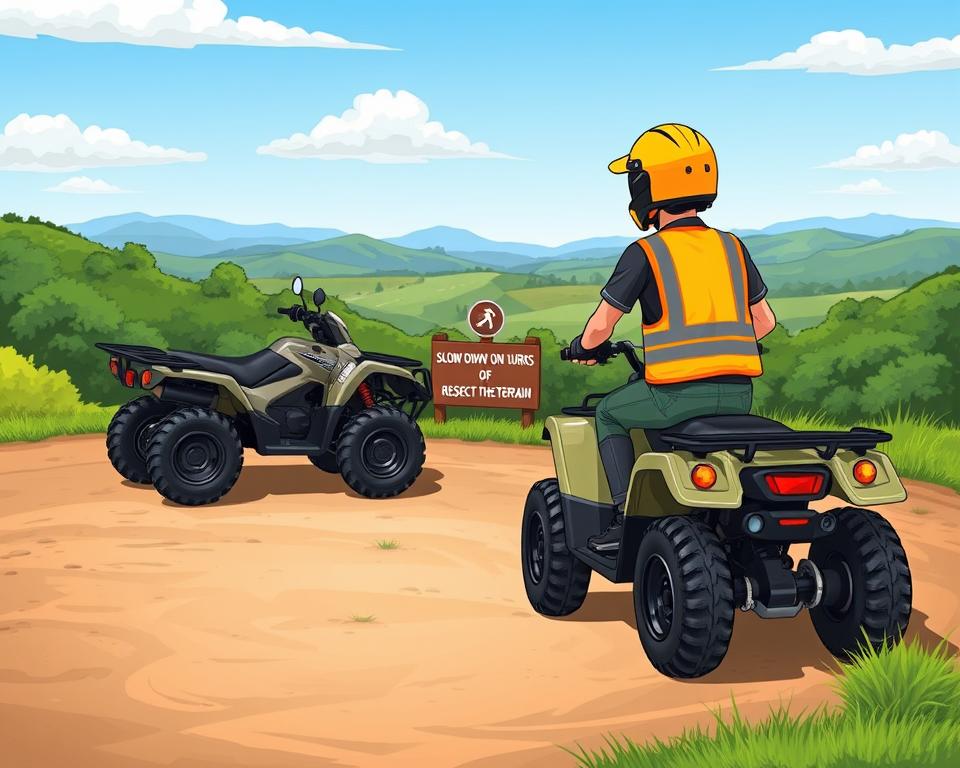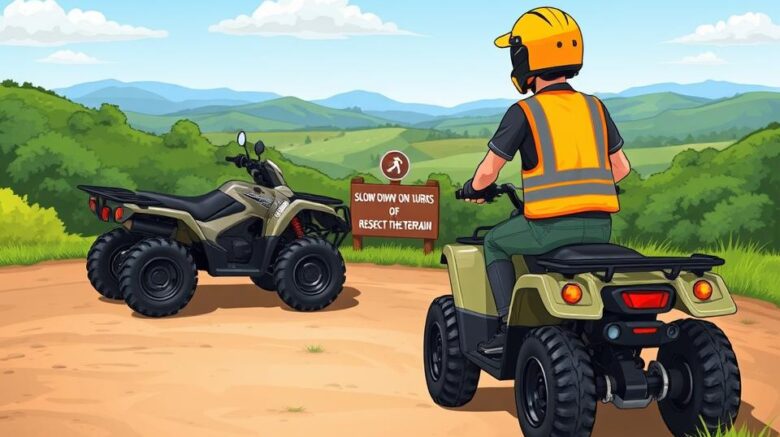Must-Have ATV Off-Road Safety Checklist
Have you heard nearly some 450,000 ATV-related injuries are treated in U.S. emergency rooms each year? This alarming figure highlights the need for safety and preparedness in off-road adventures. Here’s your go-to ATV Off-Road Checklist for maximum safety and enjoyment. It covers everything from rocky trails to sand dunes. Armed with proper safety equipment and motohavocks must-haves, you’ll reduce hazards and amplify the fun.
Key Takeaways
- Start with safety: follow this checklist for full prep.
- An ATV safety gear checklist is vital for protecting yourself during off-road rides.
- Regular maintenance is key to keep your ATV in top shape.
- Stay fueled and hydrated for peak performance.
- Don’t wander: rely on trusty navigation tools.
- Weather can flip fast—be ready with proper gear.
- Always carry essential tools and recovery kits for on-trail repairs and emergencies.
Understanding the Importance of Safety Gear
Off-road adventures require a strong focus on safety. The excitement of ATVs brings potential hazards. Safety gear is essential for protecting riders from accidents and injuries. Gear up correctly with this ATV safety gear checklist.

Essential Protective Gear
Maximizing protection involves several key items:
- Riding Helmets: Only DOT-certified lids will protect your skull.
- Goggles: Use goggles to shield your eyes from dust and debris.
- Riding Gloves: Grip and guard your hands with sturdy gloves.
- Boots: High boots shield your feet and ankles.
- Body Armor: Aggressive riders should consider body armor for extra security.
- Neck Braces: Neck braces can help reduce the risk of spinal injuries.
Emergency Preparedness
Don’t overlook your emergency kit. An effective emergency kit can be a lifesaver in unexpected situations. Key items to include are:
- First aid kit
- Multi-tool
- Tire repair kits
- Portable air compressors
- Emergency blankets
- Whistles
- Matches
ATV Equipment for Optimal Performance
Gear choices affect how well your ATV runs. Pack these essentials for any trail. Routine checks keep your ATV working its best.
Must-Have ATV Equipment
- All-Terrain Tires: Invest in tires designed for various terrains to improve traction and handling.
- Storage Solutions: Mount racks or bags to carry your gear safely.
- Fuel Reservoir: Never run low—use a proven fuel tank.
- First Aid Kit: Prepare for emergencies with a well-stocked first aid kit for immediate attention if needed.
Regular Maintenance for Longevity
Routine care keeps breakdowns at bay. Regular inspections should encompass:
- Checking air filters to keep the engine running smoothly.
- Lubricating the chain to ensure optimal performance.
- Test your brakes on every pre-ride check.
This ATV maintenance checklist is essential for keeping your vehicle in peak condition and ready for adventure.
The Essential ATV Off-Road Checklist
Good prep keeps surprise breakdowns away. An effective ATV maintenance checklist ensures your vehicle’s safety and performance. Cover every item for a worry-free ride. A thorough pre-ride assessment is key to a safe outing.
Pre-Ride Inspection Basics
Before any off-road journey, a pre-ride inspection is vital. Catch faults early with a fast inspection. Key elements to check include:
- Tire pressure and tread condition
- Fluid levels such as oil and fuel
- Brakes and controls functionality
- Operational lights and horn
- Chain or driveshaft integrity
T-CLOC Inspection Method
The T-CLOC method offers a systematic approach to inspection. Tires, Controls, Lights, Oil/Fuel, Chain—don’t miss a spot. This method ensures all critical areas are covered:
| Inspection Area | Checklist Items |
|---|---|
| Tires and Wheels | Check tire pressure, inspect tread depth, look for damage |
| Controls | Test brakes, throttle, and clutch for smooth operation |
| Lights | Ensure headlights, brake lights, and indicators are functioning |
| Oil and Fuel | Check oil level, inspect for leaks, and fill fuel tank |
| Chain/Driveshaft | Examine for wear, proper tension, and lubrication |
A quick T-CLOC saves you big trouble later. Prevent roadside repairs with a fast check.
Hydration and Nutrition for Long Rides
Long ATV rides require careful attention to hydration and nutrition. Riders often underestimate their fluid needs, making it essential to plan ahead. Carry extra water to prevent fatigue and keep energy levels up during the adventure. The right snacks are also key for maintaining stamina on the trail.
Importance of Staying Hydrated
Hydration is critical for ATV riders to stay alert and capable throughout their journey. A hydration pack with sip tube makes it easy. Hydration bladders track consumption at a glance.
High-Energy Snacks to Pack
Choosing the right snacks is vital for extended ATV rides. Opt for non-perishable items that are easy to consume. Some ideal choices include:
- Protein bars
- Nut mixes
- Dried fruits
- Beef jerky
These snacks provide a quick energy boost without hindering the riding experience. Mix sweet and salty options for flavor and function.
Navigation Tools for Off-Roading Adventures
Exploring uncharted territory demands reliable navigation tools. A dependable nav setup means you’ll always find your way.
Advanced GPS Systems
Off-road GPS with offline maps keeps you safe. Look for features like offline maps and a long-lasting battery. Garmin, TomTom, and others make GPS units built for bumps and dust.
Traditional Navigation Aids
Don’t ditch old-school compasses and maps. A compass never needs a signal. Map-and-compass know-how keeps you in control. Blend modern and classic for ultimate wayfinding.
Communication Equipment for Safety
When phones fail, two-way radios deliver. Clear comms keep your group coordinated. It gives riders peace of mind.
Don’t split up without radios in hand. Pick units with strong, clear signal range. Stay informed of detours or emergencies instantly. When choosing two-way radios, look for models with:
- Rugged, waterproof design to resist the elements
- Long battery life for extended trips without needing a recharge
- Channel selection for clear communication without interference
Adding ATV communication gear to your adventure prep is essential. They keep everyone coordinated and secure. They provide a vital communication line in tough environments. Clear comms = better rides.
Self-Rescue Gear for ATV Riders
Self-rescue gear is as vital as your helmet. With the right kit, you’ll tackle obstacles solo. A well-prepared rider not only improves their experience but also boosts safety for all.
Winches and Recovery Kits
Winches are vital for self-rescue, helping pull your ATV from tough spots. Kit up your winch for maximum extraction muscle. Recovery kits usually include:
- Tow straps
- D-rings
- Recovery boards
- Gloves
Practice recovery techniques before you need them. Be ready for anything the trail throws at you.
Trail Recovery Essentials
Your toolbox should extend beyond the winch. These include:
| Equipment | Purpose |
|---|---|
| Recovery Straps | Used for towing or pulling ATVs out of tight situations. |
| Shovel | Helps clear obstacles and dig out vehicles when stuck. |
| Traction Mats | Provides grip under tires in muddy or slick conditions. |
| Portable Air Compressor | Enables quick tire inflation after deflating for better traction. |
Arming your ATV with the right self-rescue gear ensures you can handle any obstacles. Skills plus gear equal top-tier off-road safety.
Staying Adaptable: Preparing for Weather Changes
Expect the unexpected in the outdoors. It’s vital to be ready for sudden changes to stay safe and enjoy the ride. Don’t forget your layers and rain shell.
Layering your clothes is key to adapting to temperature changes. Begin with a moisture-wicking base layer to manage sweat. Then, add insulating layers like fleece or wool that can be removed as needed. Lastly, have a waterproof and wind-resistant outer shell. Stay dry and warm through all conditions.
Weather-Appropriate Clothing
- Rain Shells: A must-have for sudden downpours.
- Ventilated Off-Road Pants: Stay cool and dry with breathable pants.
- UV Gear: Sun-blocking shirts and hats prevent overexposure.
- Cold-Weather Gloves: Insulate your hands against cold snaps.
Gear up for every climate challenge. It keeps you comfortable and safe, letting you enjoy the adventure without worrying about the weather.
Tools for On-Trail Repairs
Having the right tools for on-trail repairs is key to a safe and enjoyable off-roading experience. Don’t skimp on repair gear. These tools help address minor breakdowns or issues that may arise during your adventure.
Must-Have Tools and Kits
A well-prepared rider should assemble a basic tool kit. This kit should include essential items for quick repairs. Critical ATV repair tools might include:
- Tire irons for changing flat tires
- Pliers for gripping and cutting
- Wrenches for various sizes of bolts and nuts
- A multi-tool for versatility
- Spare items such as spark plugs and electrical wire
- Duct tape for quick fixes
Be your own mechanic on the trail.
Basic Emergency Supplies
In addition to essential tools, packing basic emergency supplies for ATV is vital. These supplies help ensure your safety in challenging situations:
- First aid kit for injuries
- Flashlight with extra batteries for night-time visibility
- Emergency whistle for signaling assistance
- Reflective triangles or flares to warn other riders
- Water and high-energy snacks for sustenance
Preparedness significantly impacts your off-roading experience. Never leave home without them.
As a Final Point
Preparation is the secret to epic trails. Using the Essential ATV off-road checklist and acquiring gear from trusted sources is key. Be set for rocks, sand, mud—anything.
Gear up fully and ride securely. Prep wisely for peak thrills and protection. Embrace excitement, ditch the doubts.
Stay ready, ride with care, and enjoy the unforgettable moments off-roading offers. The journey is as important as the destination. By following the Essential ATV off-road checklist, you’re set for an incredible adventure in the great outdoors.
FAQ
What should I include in my ATV safety gear checklist?
Include a certified helmet and eye protection. Don’t skip gloves, boots, and armor. Neck braces offer additional protection. Remember to pack an emergency kit with a first aid kit and multi-tools for preparedness.
Tips for ATV upkeep?
Keep filters clean and chain well-lubed. Always test your brakes before a ride. Regular service keeps your ATV trail-ready.
What does the T-CLOC inspection method entail?
The T-CLOC inspection method covers several key areas. Tires, Controls, Lights, Oil, and Chain are checked in T-CLOC. This ensures your ATV’s critical components are in working order before hitting the trails.
How to gauge water needs off-road?
Pack extra hydration for safety. Stay topped off to avoid dehydration. Hydro packs let you drink without stopping.
What should I bring for navigation during my off-road adventure?
For navigation, invest in an advanced GPS system designed for off-road use. Combine this with traditional aids like waterproof maps and compasses.
Why is communication important when off-roading?
Radios prevent isolation when cell fails. Radios work where phones don’t.
Essential recovery gear for off-road?
Be ready with winch and recovery essentials. This kit should include tow straps, D-rings, and recovery boards.
How can I prepare for sudden weather changes while off-roading?
Use a base, mid, and shell layering system. Don’t get caught soaked—bring waterproofs. Don’t forget sunscreen and UV-blocking apparel.
What tools should I pack for on-trail repairs?
Carry essential wrenches, pliers, and irons. Include tire irons, pliers, wrenches, a multi-tool, and spare parts like a spark plug.
